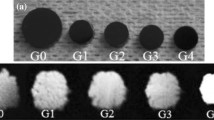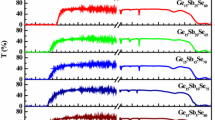Abstract
Chalcogenide glasses of the systems Ge–Sn–Se, Ge–Se–Te, and Ge–Sn–Se–Te have been prepared. Several compositions were found suitable for drawing fibers for CO2 laser radiation (λ = 10.6 μm) transmission. The glasses were characterized by x-ray diffraction, DSC (Differential Scanning Calorimetry), SEM with EDX analysis, FTIR spectrometry, density, and microhardness measurements. The glass transition temperature and microhardness of Ge–Se–Sn and Ge–Sn–Se–Te glasses decreased with increasing Sn content, for most of the samples. The region of high IR transparency of Ge–Se–Sn, Ge–Se–Te, and Ge–Sn–Se–Te glasses was slightly expanded (1–2 μm) toward longer wavelengths, compared to Ge–Se glasses, mainly for the glasses containing 70 at.% Se. The intensity of the impurity absorption peak of Ge–O (at λ ∼ 12.8 μm), which usually appears in Ge–Se glasses, was reduced or absent in Ge–Sn–Se–Te glasses. The best fibers were produced with the glass composition Ge–0.8Sn0.2Se3.5Te0.5. An attenuation of 20 dB/m at 10.6 μm, and a transmitted maximum power density of 2.4 ⊠ 106 W/m2 were measured. The mechanical and optical characteristics of these glasses have been related to the glasses structure. Corresponding to the reduced masses of the bonds formed in the Ge–Sn–Se–Te system (in the amorphous region), it is expected that the multiphonon edge is slightly shifted. As a consequence, as was measured, the transparency region has been expanded by less than 2 μm toward longer wavelengths.
Similar content being viewed by others
References
S. S. Alimpiev, V. G. Artjushenko, and L. N. Butvina, SPIE Proc. 906, 183 (1988).
D. A. Pinnow, A. L. Gentile, A. G. Standlee, and A. J. Temper, Appl. Phys. Lett. 33, 28 (1978).
Y. Imura, Y. Okamura, Y. Komazawa, and C. Ota, J. Appl. Phys. 19, L269 (1980).
J. A. Harrington, A. G. Standlee, A. C. Pastor, and L. G. Deshazer, SPIE Proc. 484, 124 (1984).
J. Dror, I. Gannot, and N. Croitoru, SPIE Proc. 108, 112 (1989).
S. Mitachi and T. Manabe, Jpn. J. Appl. Phys. 19, L313 (1980).
M. Drexhage and C. T. Moynihan, Sci. Am. 11, 76 (1988).
A. R. Hilton, J. Electron. Mater. 2, 211 (1973).
J. A. Savage, P. J. Webber, and A. M. Pitt, IR Phys. 20, 313 (1980).
A. Bornstein, N. Croitoru, and E. Marom, SPIE Proc. 320, 402 (1982).
Z. U. Borisova, Glassy Semiconductors (Plenum, New York and London, 1981), 1st ed., pp. 12, 104, 207.
M. E. Lines, Ann. Rev. Mater. Sci. 16, 113 (1986).
P. Klocek, M. Roth, and D. Rock, SPIE Proc. 572, 172 (1985).
T. Kanamori, Y. Terunuma, S. Takhashi, and T. Miyashita, J. Lightwave Technol. LT-2, 607 (1984).
T. Katsuyama, K. Ishida, S. Satoh, and H. Matsumura, Appl. Phys. Lett. 45, 925 (1984).
N. J. Pitt, G. S. Sapsford, T. V. Clapp, R. Worthington, and M. G. Scott, SPIE Proc. 618, 124 (1986).
A. Bornstein, N. Croitoru, and E. Marom, J. Non-Cryst. Solids 74, 57 (1985).
P. P. Sergin, L. N. Vasil’ev, and Z. U. Borisova, Izv. Akad. Nauk SSSR, Neorg. Mater. 8, 567 (1972).
T. Fukunaga, Y. Tanaka, and K. Murase, Solid State Commun. 42, 513 (1982).
M. Stevens and P. Boolchand, Phys. Rev. B 31, 981 (1985).
N. Croitoru and N. Shamir, J. Lightwave Technol. LT-5, 1637 (1987).
J. C. Phillips, J. Non-Cryst. Solids 34, 153 (1979).
P. Boolchard and M. Stevens, Phys. Rev. Β 29, 1 (1984).
S. Lezal, I. Kasik, and J. Götz, J. Non-Cryst. Solids 90, 557 (1987).
A. R. Hilton, C. C. Jones, and M. Brau, Phys. and Chem. Glasses 7, 105 (1966).
D. R. Goyal, A. K. Sharma, and A. S. Mann, J. Mater. Sci. Lett. 7, 783 (1988).
L. Pauling, The Nature of the Chemical Bonds (Cornell University Press, 1960), 3rd ed., pp. 85, 92.
Author information
Authors and Affiliations
Rights and permissions
About this article
Cite this article
Haruvi-Busnach, I., Dror, J. & Croitoru, N. Chalcogenide glasses Ge–Sn–Se, Ge–Se–Te, and Ge–Sn–Se–Te for infrared optical fibers. Journal of Materials Research 5, 1215–1223 (1990). https://doi.org/10.1557/JMR.1990.1215
Received:
Accepted:
Published:
Issue Date:
DOI: https://doi.org/10.1557/JMR.1990.1215




